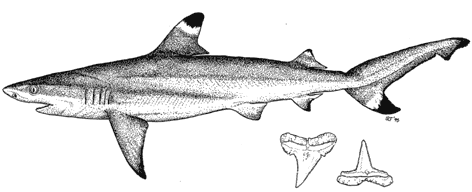Blacktip Reef Shark (Carcharhinus melanopterus)

(Quoy & Gaimard, 1824).
| Fr: |
Requin-pointes noires |
| Sp: |
Tiburon de puntas negras |
| It: |
Squalo pinna nera |
| Ma: |
N/A |
Diagnosis
A rather small shark (under 1.6m) with conspicuous, black-marked
fin tips. Snout rather short and rounded with prominent nasal
flaps; eyes oval; no interdorsal ridge; 1st dorsal fin
medium-sized (height 8 - 11.4% of TL) with its origin above or just
posterior to the inner corner of the pectoral fins; 2nd dorsal
moderately large with a short rear tip, anal fin of similar size and
positioned directly below. Upper teeth rather narrow,
generally oblique, with serrated margins and enlarged serrae and
cusplets at the bases. Colour light grey-brown dorsally,
fading to white ventrally; darker horizontal band invading the white
flanks. Tip of 1st dorsal and lower caudal fin marked with
conspicuous black blotches, surrounded into the fin interior with
white; other fins with less marked black or dark apexes; trailing
edge of caudal fin often clearly lined in black.
Size
Exceptionally to 180cm TL; mostly under 160cm TL; size at
birth 33 to 52 cm.
Status and Distribution
A tropical Indo-Pacific species which may be considered a recent
addition to the Mediterranean fauna (Tortonese, 1964), where it is
rare or occasional with a range perhaps increasing in warmer
southern areas. Currently found from Cyprus, Lebanon and
Israel to at least Cape Bon, Tunisia, originally as migrants via
Suez Canal from Red Sea. Reported (very infrequently)
from Maltese fishmarkets, probably as specimens taken by fisheries
operating towards the Libyan coast where these sharks are apparently
not uncommon in the Gulf of Sidra. Not yet recorded from the
fishery at Mazara del Vallo (Sicily) but a likely addition giving
the extensive geographical remits of the fishing-fleet based there.
Biology
A coastal or littoral shallow-water species typically associated
with coral reef communities; within Mediterranean waters it tends to
occur in clearer waters in bays and along the margins or sandy flats
of shallow banks, also around islets and headlands, over rocky or
sandy substrate and often adjacent to drop-offs or channels to a
maximum depth of 100m but more commonly in depths under 20m.
These sharks are active swimmers, generally near the bottom but
sometimes visible cruising at the surface in very shallow,
wading-depth waters; either singly or in small, loose
aggregations. Preys upon a wide range of smaller
demersal or inshore bony fish, including jacks, mullet, sea breams
and smaller groupers; also octopi, squid, cuttlefish and
occasionally shrimps. Activity levels increase markedly at
night and tagging studies in Pacific waters suggest that these
sharks may inhabit the same microsites for at least 2 years.
Biology and ecology in Mediterranean waters poorly known.
Viviparous. Litter size 2 - 5 pups, generally 4 or less;
gestation period perhaps as much as 16 months. Females mature
at 96 - 112cm TL; males between 91 - 100cm.
The Shark Trust, 36 Kingfisher Court, Hambridge Road, Newbury, Berkshire, RG14 5SJ, UK.
Tel(+44) 01635 551150, Fax(+44) 01635
550230
|